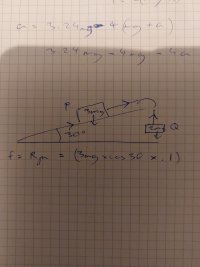James10492
Junior Member
- Joined
- May 17, 2020
- Messages
- 50
Hello good math people,
I am having a bit of difficulty with this problem which I have spent a long time looking at, I thought I had come up with the solution, and then I checked my answer and it turns out it is wrong. I feel like I need another set of eyes at this point to check my working.
Here is a quick sketch diagram of the problem from my notebook:

"Two boxes, P and Q, of masses 3m kg and 2m kg respectively, are attached to the ends of a light inextensible string. Box P lies on a rough surface that is inclined at 30 degrees to the horizontal. The coefficient of friction (myu) between the box and the surface is .1"
The system is released from rest with the strings taut.
Work out the time taken for P to reach a speed of 10m/s".
(You need to formulate equations of motions to work out the acceleration of the particles. Through a bit of trial and error I worked out that the system is accelerating towards the right-hand side of the diagram):
[math]2mg - T = 2ma \\ T - 3mg\sin 30 - F = 3ma[/math]
F = R x myu = 3mgcos30 x myu, so [math]T - 3mg\sin30 - .1(3mg\cos30) = 3ma \\ T - \frac{1}{2}mg(3-.3\sqrt3) = 3ma \\ T-1.24 mg = 3ma[/math]
Now you can add the simplified equations of motion to determine the acceleration of the system:
[math]3ma=T-1.24mg\\ 2ma=2mg-T\\ 5ma=.76mg \\ a = .152g[/math]
.152g = .152 x 9.8 = 7.5m/s^2
Now P started at rest, so the initial velocity is 0,
final velocity is 10,
10 = 7.5 x t
t = 1.33 (wrong answer)
What am I doing wrong?
I am having a bit of difficulty with this problem which I have spent a long time looking at, I thought I had come up with the solution, and then I checked my answer and it turns out it is wrong. I feel like I need another set of eyes at this point to check my working.
Here is a quick sketch diagram of the problem from my notebook:

"Two boxes, P and Q, of masses 3m kg and 2m kg respectively, are attached to the ends of a light inextensible string. Box P lies on a rough surface that is inclined at 30 degrees to the horizontal. The coefficient of friction (myu) between the box and the surface is .1"
The system is released from rest with the strings taut.
Work out the time taken for P to reach a speed of 10m/s".
(You need to formulate equations of motions to work out the acceleration of the particles. Through a bit of trial and error I worked out that the system is accelerating towards the right-hand side of the diagram):
[math]2mg - T = 2ma \\ T - 3mg\sin 30 - F = 3ma[/math]
F = R x myu = 3mgcos30 x myu, so [math]T - 3mg\sin30 - .1(3mg\cos30) = 3ma \\ T - \frac{1}{2}mg(3-.3\sqrt3) = 3ma \\ T-1.24 mg = 3ma[/math]
Now you can add the simplified equations of motion to determine the acceleration of the system:
[math]3ma=T-1.24mg\\ 2ma=2mg-T\\ 5ma=.76mg \\ a = .152g[/math]
.152g = .152 x 9.8 = 7.5m/s^2
Now P started at rest, so the initial velocity is 0,
final velocity is 10,
10 = 7.5 x t
t = 1.33 (wrong answer)
What am I doing wrong?
